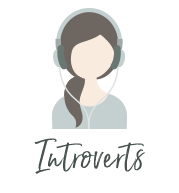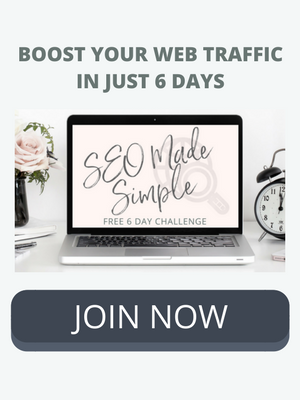3 (Surprising) Reasons Your Blog Isn't Ranking + What To Do About It [Part 1]
/If you’re trying to figure out how to get more traffic to your website or you’re wanting better quality traffic, as in, more highly qualified leads and more ideal clients, then don’t fear! With a little know how it’s possible to vastly improve your search engine ranking. You may be surprised to learn there are way more than three reasons why your blog isn’t ranking, but they can actually be grouped into three main topics:
Part 1 | Simple issues with your branding & content which are easy-to-fix
Part 2 | Search is evolving, don’t get left behind!
Part 3 | Core SEO fundamentals you shouldn’t neglect
I’m passionate about what SEO it can do for your business, but I don’t want to overwhelm you, so I’m breaking each topic down into a series of three parts. I want to help you soar through the rankings, so let’s make it happen…
First up: Part 1 of why your blog isn't ranking in search
Your content and blog is a vital part of improving your SEO. But it’s easy to make newbie mistakes or just not get around to developing a more strategic approach.
If you’d like to see your site rank higher, let’s figure out where you can improve your SEO and overall content strategy… Ready to up your content game?
Here are my top 8 tips for developing a content strategy, improving brand awareness and increasing engagement.
Simple issues with your branding & content which are easy-to-fix
1 | Your blog’s niche isn’t obvious
When landing on your homepage and blog feed, is your niche obvious?
To help ideal clients decide to stick around, make sure you have clear & cohesive messaging in these areas:
Tone of voice – are you infusing your content with your natural voice and personality?
Branding – are you maintaining your brand’s visual style?
Creative Market* is a great source of affordable brand images.
Free graphic editors, such as Canva*, help you pull together brand images quickly.
Copy (writing) – are you communicating in a succinct, clear and direct manner, while speaking to the hearts of your clients?
Can people tell within a few seconds what your niche is?
2 | You’re posting content based on quantity rather than quality
Posting regularly is important, but it can be hard to manage weekly blogs when you don’t have a content strategy in place.
It’s easier than you think to get stuck in this mode – there’s:
The pressure to post frequently
A lack of planning
Creating knee-jerk, last-minute posts
You’re delivering too many personal posts and not enough solution-focused, client-friendly posts
Search engines prize relevant content above all else, so quality content is always preferable over quantity.
However, if you want to get into a regular posting rhythm, you could:
Start planning your content at least 2-3 weeks in advance, taking your holidays and launches into account.
Use a free project manager to create workflows, templates, systems and task checklists – Asana is my #1 project management tool, but some people love Trello and use them both.
Create link round-up posts where you’re sharing other people’s content you’re enjoying.
Invite other bloggers and business owners to submit guest posts.
When you can’t think what to write, find an old post to update – there are 50 ways you can breathe new life into blog posts!
3 | You’re not writing with your audience in mind
This is my favorite tip!
When you focus on your ideal client and what they’re seeking, then your content becomes packed with value.
In order to do this, you need to consider:
The solutions, goals, and results they’re looking for
The frustrations, issues and pain points they’re dealing with
What search terms they’d use (more on that in Part 3)
You also need to stand out and persuade your audience to click-through, whether that’s in search results, email lists or on social media. Writing result-oriented headlines can make the difference between a thriving tribe and crickets.
4 | Your audience isn’t sticking around or engaging
Encouraging your readers to hang out, explore your website and get involved in conversations, will help create an online hub.
How?
You can:
Link to related posts on your blog, AKA internal linking – this helps search engines, like Google, understand your site and how your content is related.
Include a Call-To-Action at the end of each post to encourage comments – try open-ended questions related to the topic in your post.
Offer a way to subscribe, so you don’t lose out on growing a community of warm leads.
Increase your shareability, with Pinterest-worthy images (I’ll give you more shareability ideas in a moment)
5 | Your content isn’t easy on the eye
Bearing in mind your brand aesthetic and the ideal client you’re writing for, most people expect blogs to be displayed in a certain format.
Instead of creating walls of text found in magazines and newspapers, make your blog reader-friendly:
Have clarity through use of white space and one “stand-out” color for links
Create scannable posts with persuasive sub-headings and layout body text in smaller chunks
Keep your content easy-to-read with larger-sized, clear serif or sans-serif fonts; saving script-style fonts for flourishes
Use occasional images/videos/gifs, two or more different-sized headings, bold and italic text, quotes, bullet points etc. to break up content.
6 | Your site is brand new
Google takes 2-3 weeks to start ranking your website – the sooner you start your blog, the better, but be patient too.
Growing your website traffic organically will give you a more engaged audience.
7 | You don’t have your own domain & web host
Starting off using a free blogging platform, like Blogspot, Typeform or Tumblr, etc. is a great way to keep costs down when you’re experimenting. But if you want to be taken seriously as a business owner (and make money from your blog), you really need your own domain and host.
That means your website address becomes www.yourchosenname.com, rather than e.g. www.yourchosenname.wordpress.com.
And, if you’re attempting to build your business on a social media platform, please don’t! You need to have your own website.
Even for “side hustles”, getting set-up online is affordable these days. You simply need to:
Register your domain (.com, .co, .org, .net, etc.; typically $10 per year)
Buy web space from a reliable web hosting company, like Bluehost*. ($10+ per month depending on servers/space required)
Build your website you can:
Hire a web designer for a premium price, or
Build your own using site-building software – some web hosts offer this, or you can use:
Open source, free software, like WordPress.org (they’re the most popular, with 51% of the market share, with thousands of design options, but unfortunately, they’re targeted by hackers, so I’d recommend having security installed).
Paid platforms, like Squarespace (from $12 a month which includes hosting. It’s popular with creatives and security is built in.)
8 | You HAVEN'T optimized for increasing social media traffic
It’s vital that you make it possible for your posts to be shared on social media as this improves your credibility and SEO (in addition to all those shares).
Optimize your website for social media:
Include sharing icons at the end of your posts &/or use a “floating” bar which follows the reader down the page.
Create pin-worthy branded images – Pinterest is a fantastic tool for growing your blog.
Create 1 – 3 tweetable quotes every few paragraphs to encourage sharing on Twitter using the free Click To Tweet app.
Don’t miss out on Reasons Your Blog Isn't Ranking Part 2 & Part 3!
Want to expedite your blog rankings and traffic? Join my FREE 6-day Challenge: SEO Made Simple:
How many of those content and branding tips are you already doing?
Any A-HA moments? Confess in the comments below!
Disclaimer: * Links with an * designate affiliate links. I'm only an affiliate for trusted companies that I would use regardless.
















